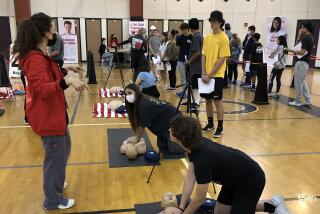CPR: taught in a flash
- Share via
CPR is an important way to keep people alive after heart attacks until more care can be provided. It’s a crucial skill, not just for emergency responders, but also for the general public, as the first few minutes after an attack are the most critical.
But CPR classes generally take three to four hours -- which discourages many people from taking them.
Perhaps all that time isn’t necessary. In a study reported July 25 in the journal Resuscitation, researchers tested 30-minute CPR courses against longer ones. The authors, emergency physicians at the University of Texas Southwestern Medical Center in Dallas, found that performance of CPR -- cardiopulmonary resuscitation -- immediately following training and again, after a critical six-month retention period, was as good or better in those who took the short course as in those who took the longer course.
There were also no differences in learning -- and remembering -- how to use an automated external defibrillator.
Longer courses require one instructor and manikin for every six to eight people, therefore offering students little time to actually practice CPR.
The short course, in contrast, had participants watching a DVD while practicing CPR, each on his or her own manikin.
A facilitator was present to reposition hands or give other nonverbal help, but there was only one per 29 people.
A corporate setting -- American Airlines -- was used in the study because so many firms now have automated external defibrillators that people may not know how to use.
The study randomly assigned almost 300 American Airlines employees at the company’s Dallas headquarters to either a long or short course.
In tests administered right after the courses, the only significant difference between the two groups was that the short-course students were more likely to call 911, as they should, and use proper ventilation technique, the breathing of expired air into the victim’s mouth.
After six months, both groups showed declines in skill retention, but there were no significant differences.
Nor were there significant differences at either time in correct usage of the automated external defibrillator. Every such defibrillator has voice prompts, so the only things to remember are to recognize that a person needs help, open the box and follow instructions.
The short course included only five minutes of defibrillator instruction.
These results show that CPR is more of a so-called psychomotor skill requiring muscle memory -- “like riding a bike,” says study senior investigator Dr. Ahamed Idris, a University of Texas emergency physician.
It suggests that CPR teachers should focus on hands-on CPR practice rather than lecturing.
It also suggests that defibrillator training, in contrast, does not need as much hands-on practice as longer classes generally provide, Idris says.
--
Cost, time barriers overcome
This research is important, said the American Heart Assn. in a statement, because the short course overcomes time and cost barriers for a large segment of the population.
The association has begun using some of the study results in a traditional course that is mostly used for training healthcare professionals and others who require certification, said association spokeswoman Tagni McRae.
CPR relies on chest compressions and ventilation to keep blood flowing to the brain and heart of a cardiac arrest victim.
Automated external defibrillators, which shock a heart back into normal rhythm, can be used in place of CPR, although sometimes the instructions recommend not shocking the victim. In this case, knowledge of CPR is essential.
This is not the first study to have found short-term equivalence between the two courses, but it is the first to test long-term retention, says University of Texas emergency physician Lynn Roppolo, the study’s lead investigator.
“An individual’s ability to perform CPR skills immediately following instruction is one thing,” Roppolo says. “Their ability to perform these same skills several months later is another, and probably more important.”





